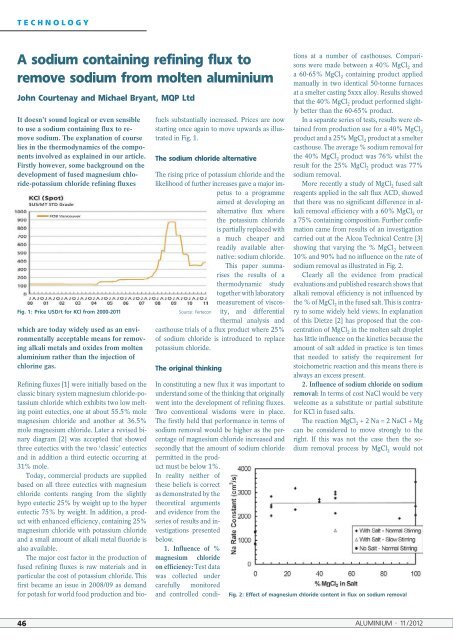special - ALUMINIUM-Nachrichten – ALU-WEB.DE
special - ALUMINIUM-Nachrichten – ALU-WEB.DE
special - ALUMINIUM-Nachrichten – ALU-WEB.DE
Create successful ePaper yourself
Turn your PDF publications into a flip-book with our unique Google optimized e-Paper software.
TECHNOLOGY<br />
A sodium containing refining flux to<br />
remove sodium from molten aluminium<br />
John Courtenay and Michael Bryant, MQP Ltd<br />
It doesn’t sound logical or even sensible<br />
to use a sodium containing flux to remove<br />
sodium. The explanation of course<br />
lies in the thermodynamics of the components<br />
involved as explained in our article.<br />
Firstly however, some background on the<br />
development of fused magnesium chloride-potassium<br />
chloride refining fluxes<br />
Fig. 1: Price USD/t for KCl from 2000-2011<br />
which are today widely used as an environmentally<br />
acceptable means for removing<br />
alkali metals and oxides from molten<br />
aluminium rather than the injection of<br />
chlorine gas.<br />
Refining fluxes [1] were initially based on the<br />
classic binary system magnesium chloride-potassium<br />
chloride which exhibits two low melting<br />
point eutectics, one at about 55.5% mole<br />
magnesium chloride and another at 36.5%<br />
mole magnesium chloride. Later a revised binary<br />
diagram [2] was accepted that showed<br />
three eutectics with the two ‘classic’ eutectics<br />
and in addition a third eutectic occurring at<br />
31% mole.<br />
Today, commercial products are supplied<br />
based on all three eutectics with magnesium<br />
chloride contents ranging from the slightly<br />
hypo eutectic 25% by weight up to the hyper<br />
eutectic 75% by weight. In addition, a product<br />
with enhanced efficiency, containing 25%<br />
magnesium chloride with potassium chloride<br />
and a small amount of alkali metal fluoride is<br />
also available.<br />
The major cost factor in the production of<br />
fused refining fluxes is raw materials and in<br />
particular the cost of potassium chloride. This<br />
first became an issue in 2008/09 as demand<br />
for potash for world food production and biofuels<br />
substantially increased. Prices are now<br />
starting once again to move upwards as illustrated<br />
in Fig. 1.<br />
The sodium chloride alternative<br />
The rising price of potassium chloride and the<br />
likelihood of further increases gave a major impetus<br />
to a programme<br />
aimed at developing an<br />
alternative flux where<br />
the potassium chloride<br />
is partially replaced with<br />
a much cheaper and<br />
readily available alternative:<br />
sodium chloride.<br />
This paper summarises<br />
the results of a<br />
thermodynamic study<br />
together with laboratory<br />
measurement of viscosity,<br />
and differential<br />
Source: Fertecon<br />
thermal analysis and<br />
casthouse trials of a flux product where 25%<br />
of sodium chloride is introduced to replace<br />
potassium chloride.<br />
The original thinking<br />
In constituting a new flux it was important to<br />
understand some of the thinking that originally<br />
went into the development of refining fluxes.<br />
Two conventional wisdoms were in place.<br />
The firstly held that performance in terms of<br />
sodium removal would be higher as the percentage<br />
of magnesium chloride increased and<br />
secondly that the amount of sodium chloride<br />
permitted in the product<br />
must be below 1%.<br />
In reality neither of<br />
these beliefs is correct<br />
as demonstrated by the<br />
theoretical arguments<br />
and evidence from the<br />
series of results and investigations<br />
presented<br />
below.<br />
1. Influence of %<br />
magnesium chloride<br />
on efficiency: Test data<br />
was collected under<br />
carefully monitored<br />
and controlled conditions<br />
at a number of casthouses. Comparisons<br />
were made between a 40% MgCl 2 and<br />
a 60-65% MgCl 2 containing product applied<br />
manually in two identical 50-tonne furnaces<br />
at a smelter casting 5xxx alloy. Results showed<br />
that the 40% MgCl 2 product performed slightly<br />
better than the 60-65% product.<br />
In a separate series of tests, results were obtained<br />
from production use for a 40% MgCl 2<br />
product and a 25% MgCl 2 product at a smelter<br />
casthouse. The average % sodium removal for<br />
the 40% MgCl 2 product was 76% whilst the<br />
result for the 25% MgCl 2 product was 77%<br />
sodium removal.<br />
More recently a study of MgCl 2 fused salt<br />
reagents applied in the salt flux ACD, showed<br />
that there was no significant difference in alkali<br />
removal efficiency with a 60% MgCl 2 or<br />
a 75% containing composition. Further confirmation<br />
came from results of an investigation<br />
carried out at the Alcoa Technical Centre [3]<br />
showing that varying the % MgCl 2 between<br />
10% and 90% had no influence on the rate of<br />
sodium removal as illustrated in Fig. 2.<br />
Clearly all the evidence from practical<br />
evaluations and published research shows that<br />
alkali removal efficiency is not influenced by<br />
the % of MgCl 2 in the fused salt. This is contrary<br />
to some widely held views. In explanation<br />
of this Dietze [2] has proposed that the concentration<br />
of MgCl 2 in the molten salt droplet<br />
has little influence on the kinetics because the<br />
amount of salt added in practice is ten times<br />
that needed to satisfy the requirement for<br />
stoichometric reaction and this means there is<br />
always an excess present.<br />
2. Influence of sodium chloride on sodium<br />
removal: In terms of cost NaCl would be very<br />
welcome as a substitute or partial substitute<br />
for KCl in fused salts.<br />
The reaction MgCl 2 + 2 Na = 2 NaCl + Mg<br />
can be considered to move strongly to the<br />
right. If this was not the case then the sodium<br />
removal process by MgCl 2 would not<br />
Fig. 2: Effect of magnesium chloride content in flux on sodium removal<br />
46 <strong><strong>ALU</strong>MINIUM</strong> · 11/2012
















